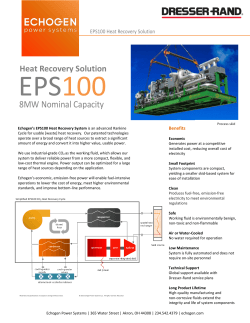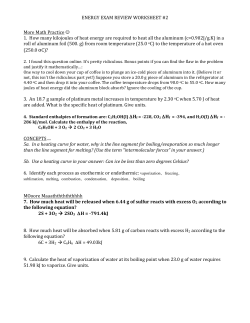
Full Text
Journal of Advanced Chemical Sciences 1(2) (2015) 53–55 ISSN: 2394-5311 Contents List available at JACS Directory Journal of Advanced Chemical Sciences journal homepage: www.jacsdirectory.com/jacs Photo-catalytic Reduction of CO2 to Ethanol S. Basumallick* Chemistry Department, National Institute of Technology Agartala, Agartala – 799 046. Tripura, India. ARTICLE DETAILS Article history: Received 16 February 2015 Accepted 23 February 2015 Available online 27 February 2015 Keywords: CO2 reduction Photo catalyst Acetate coated–copper oxide ABSTRACT We report here photo-catalytic reduction of CO2 to ethanol by Cu2O nano catalyst dispersed onto p-type Si-wafer. The catalyst was synthesized by simple hydrothermal reaction of Cu(I) -acetate salt. The purified catalysts were characterized by AFM, TEM and XPS. A boron doped Si-wafer was spin coated with a thin film of aqueous dispersions of the catalyst for photo-reduction of CO2. We observed signature of ethanol in NMR analysis of photo-reduction products. The mechanism of ethanol formation has been discussed. 1. Introduction During the recent years, there is an increasing interest [1-9] in the development of photo-catalysts and electro-catalysts for CO2 reduction. Carbon dioxide is a greenhouse gas and causes global warming to a large extent. Natural photosynthetic pathway or carbon pathway [2] is not capable of restoring the ecological CO2 balance because of rapidly increasing global carbon emission. Thus, CO2 utilization through its photochemical or electro-chemical reduction [1-8] to alcohol or hydro-carbon is an additional effective path in restoring CO2 balance. But major bottleneck of CO2 reduction reaction is that it is thermodynamically non spontaneous reaction and kinetically difficult because of requirement of high activation energy. In natural photosynthetic dark reaction, free energy released by conversion of ATP to ADP and reducing molecule NADPH are used to fix and reduce CO2 to carbohydrate. The enzyme Ribulose Bisphosphate Carboxylase (RuBPCO) acts as catalyst. In laboratory experiments with CO2 reduction using sun light or electrical energy, it is reported [2,8,9] Cu2O is an efficient catalyst for such reduction. This is because of its unique band gap energy (2.2 eV) matches absorption of visible light and CO 2 molecules are easily adsorbed onto crystal lattice of Cu 2O. Calculated values of heat of adsorption show favourable interactions between CO 2 molecules and Cu2O. Apart from these, high optical absorption coefficient and simplicity in preparation of Cu2O make it an attractive candidate for photo-voltaic application. In this paper, we report our works on one step hydrothermal method of preparation of copper –oxides nano particles and their catalytic activity towards photo reduction of CO2. 2. Experimental Methods 2.1 Materials CuSO4, 5H2O, NaOH (Sigma-Aldrich) and AcOH, HCl (technical grade, Fisher Scientific) were used as supplied. Hydrothermal reaction was carried out in a hard glass bomb keeping in a temperature controlled oven (Thermo electron corporation, Lundeberg/Blue M). A Mettler Toledo, Delta 320 pH meter was used to adjust pH of the solution after calibrating it using HACH pH calibration solutions. Barnsted Nano pure Diamond DI water system was used to obtain DI water of resistivity 17.9MΩ-cm. Fisher scientific digital vortex mixer was used to mix reagents for reaction. *Corresponding Author Email Address: srijitabasumallick@gmail.com (S. Basumallick ) 2.2 Methods We have modified the literature [10] protocol of preparing copper (I)oxide nanoparticles. Exactly 300 mg of CuSO4, 5H2O was dissolved in 30 mL of 10% AcOH solution followed by hydrothermal reaction at 300 C for 1.5 hr followed by adjustment of pH to 7.4. This dispersion was dialysed against DI water, centrifuged and dried under vacuum. It is proposed that cupric acetate undergoes reduction and decomposition under hydrothermal condition forming Cu and Cu 2O. 2.3 AFM Images Silicon wafer (boron doped) was purchased from Nova electronic materials water dispersed sample was spin coated and dried in vacuum. AFM images were recorded on a Veeco Manifold multimode V model (tapping mode) using silicon nitride tip (radius B 50 nm) attached to a cantilever (spring constant = 0.032 Nm, oscillating frequency 0-600 k Hz). AFM images were recorded at room temperature. 2.4 TEM Images FEI Tecnai TEM with resolution 0.20 nm point to point, 0.102 nm per line was used. The machine was equipped with SEG with hot and cold stages and High angle annular dark field (HAADF) detector using Gatan Image Filter (GIF). The lyophilized catalyst powder was dispersed in ethanol. Au grid with carbon mass was directly dipped in to the solution and after absorption was dried under vacuum for 24 hr to remove any solvent. 2.5 XPS Images X-Ray Photoelectron Spectroscopy (XPS) was performed on a Physical Electronics 5400 ESCA spectrometer equipped with a monochromatic Al Ka source operating at 300 W. Vision software provided by the manufacturer was used for data analysis and quantification. A Shirley background was used for quantification and curve fitting of Cu2p, C1s, N1s and O1s spectra. All the spectra were charge referenced to the aliphatic carbon at 285 eV. For curve-fits, 70% Gaussian and 30% Lorentzian line shape was used. 2.6 NMR Spectroscopy NMR spectra were recorded with a Varian Gemini-500 (500 MHz for 1H) or spectrometer with D2O as solvent. After photo-catalytic reduction of saturated CO2 solution the silicon wafer coated catalyst was taken in vial and washed with D2O to leach out the products. 2394-5311 / JACS Directory©2015. All Rights Reserved Cite this Article as: S. Basumallick, Photo-catalytic reduction of CO2 to ethanol, J. Adv. Chem. Sci. 1 (2) (2015) 53–55. 54 S. Basumallick / Journal of Advanced Chemical Sciences 1(2) (2015) 53–55 2.7 Fabrication of Catalyst Coated Si-wafer and Photo Reduction Setup Cu2p3/2 for Cu(II) A 1cm2 silicon wafers was cut and cleaned with dilute HCl, water and ethanol followed by air drying. Chitosan coated copper nano particles disperser in water was spin coated at exact same condition as the AFM samples were prepared. In a 10 ml cylindrical vessel measured amount of Na2CO3 was taken then HCl was injected for full neutralization of Na 2CO3 inside. Silicon wafers coated with catalyst and were placed carefully in the CO2 saturated solution. The whole set up was kept for 8 hr under direct sun-light. A control experiment was performed wrapping the container with a black paper. Shake up peak for Cu2p1/2 Cu2p1/2 Shake up peak for for Cu(II) Cu2p3/2 for Cu(II) Cu2p3/2 for Cu(I) 3. Results and Discussion The AFM image (Fig. 1) clearly shows mono dispersed nano formation. The particles are dispersible in water. The particle sizes vary from 40-250 nm. This is been confirmed from TEM image latter. The particles are almost spherical. From TEM image (Fig. 2), presence of copper nanoparticles are seen with calculated d spacing values of 4.2 Å, exactly matching with Cu2O, 111 planes. It is worth mentioning that 111 plane is best for catalytic activity in CO2 reduction reaction facing up in our case. The diameters of the Cu2O nano particles varied from 50-250 nm indicating formation of nearly mono dispersed nanoparticles of Cu2O. The XPS spectra (Fig. 3) shows presence of different mixed valent copper both Cu+ and Cu2+ copper oxide samples. The presence of 934 ev peak is characteristic to Cu(I) whereas the peak at 936 ev together with shake up peaks indicates presence of Cu(II) peaks as well as acetate coatings. The acetate coated copper catalyst solution was drop casted on to the Si-wafer. It nicely stuck to the wafer. The copper nanoparticles are well dispersed as seen in AFM images. After exposing the catalysts coated Siwafer dipped in CO2 saturated solution to direct sunlight for 8 hours and analyzing the products by NMR (Fig. 4), we get an indication of formation ethanol as major photo-reduction products of CO2. It may be mentioned that Liu et al [11] also observed exclusive formation of ethanol as photo-catalytic reduction product using BiVO4 as photo- catalyst. Xia et al [12] studied photo-reduction of CO2 with multi walled CNT-TiO2 composites catalyst and noted that ethanol is a major product when the catalyst was prepared by sol-gel technique but formic acid was formed as major product with catalyst prepared by hydrothermal method. We have also observed [13] formation of formic acid with CuxO catalyst prepared using depolymerized chitosan. In fact, different photoreduction products like methane, methanol, ethanol, formic acid, ethane etc. are obtained [14, 15] depending on nature of catalysts, their size, shapes and reaction conditions particularly pH of the solution. Fig. 3 XPS image of the prepared Cu-oxide catalyst. Fig. 4 NMR of the products leached in D2O Admittedly, the quantum yield of such conversion is extremely small but the signature of ethanol is indicated from simple NMIR analysis. It may be mentioned that the reaction was carried out under moist condition, there are huge noise peaks in this simple NMR product analysis method. We propose formation of ethanol according to the following scheme [13]: This is initiated by water splitting reaction [9] and formation of CO2 radical ion onto catalyst surface by electronation. CO2 (ad) •CO2 CO (ad) •CO- + + + + e (CB) H• (ad) e (CB) H• (ad) = = = = •CO2 - CO (ad) + OH- •CO•C + •OH Formation carbonaceous deposit onto catalyst surface supports this scheme. •C + xH+ + xe + e •CH + •CH + H+ 2 2 • C 2 H5 + •OH •OH = •CHx = •C2 H5 = C2H5 OH radicals are formed at the hole sites of semiconductor. 4. Conclusion Fig. 1 AFM image of copper-oxide catalyst We have synthesized Cu2O nano photo-catalyst by simple hydrothermal method and demonstrate that it reduces CO2 with ethanol as major product. We have explained the formation of ethanol by well-known carbon radical formation path. Acknowledgement The author gratefully acknowledged the support of Dr. Swadesh mucus Santra of UCF. References [1] [2] [3] [4] Fig. 2 TEM image of copper-oxide catalyst [5] J.C.S. Wu, H.M. Lin, Photo reduction of CO2 to methanol via TiO2 Photocatalyst, Int. J. Photoenergy 07 (2005) 115-120. K. Hirano, K. Inoue, T. Yatsu, Photo catalysed reduction of CO2 in aqueous TiO2 suspension mixed with copper powder, J. Photochem. Photobiol. A Chem. 1 (1992) 255. C. Costentin, M. Robert, J. M.Saveant, Catalysis of the electrochemical reduction of carbon dioxide, Chem. Soc. Rev. 42 (2013) 2423-2436. H. Takeda, O. Ishitani, Development of efficient photocatalytic systems for CO2 reduction using mononuclear and multinuclear metal complexes based on mechanistic studies, Coord. Chem. Rev. 254 (2010) 346-354. D. Windle, R.N. Perutz, Advances in molecular photocatalytic and electrocatalytic CO2 reduction, Coord. Chem. Rev., 256 (2012) 2562-2570. Cite this Article as: S. Basumallick, Photo-catalytic reduction of CO2 to ethanol, J. Adv. Chem. Sci. 1 (2) (2015) 53–55. S. Basumallick / Journal of Advanced Chemical Sciences 1(2) (2015) 53–55 [6] J.A. Keith, E.A. Carter, Theoretical insights into pyridinium-based phootoelectrocatalytic reduction of CO2, J. Am. Chem. Soc. 134 (2012) 75807583. [7] T. Cottineau, M. Morin, D. Belanger, Modification of p-type silicon for the photoelectrochemical reduction of CO2, ECS Transactions 19(35) (2009) 1-7. [8] S. Liu, Z. Zhao, Z. Wang, Photocatalytic reduction of carbon dioxide using solgel derived titania-supported CoPc catalysts, Photochem. Photobiol. Sci. 6 (2007) 695-700. [9] Z. Xiong, M. Zheng, S. Liu, L.Ma, W. Shen, Silicon nanowire arrey/Cu2O crystalline core-shell nanosystem for solar-driven photocatalytic water splitting, Nanotechnol. 24 (2013) 265402-265409. [10] M. Yin, C.K. Wu, Y.B. Lou, C. Burda, J.T. Koberstein, Y.M. Zhu, S. Brien, Copper oxide nanocrystals, J. Am. Chem. Soc. 127 (26) (2005) 9506-9511. 55 [11] Y. Liu, B. Huang, Y. Dai, X. Zhang, X. Qin, M.J. M-H Whangbo, Selective ethanol formation from photocatalytic reduction of carbondioxide in water with BiVO4 photocatalyst . Catalys. Comm. 11 (2009) 210–2013. [12] X.H. Xia, Z.J. Jia, Y. Yu, Y. Liang, Z. Wang, L.L. Ma, Preparation of multi-walled carbon nanotube supported TiO2 and its photocatalytic activity in the reduction of CO2 with H2O, Carbon 45 (2007) 717–721. [13] S. Basumallick, Chitosan coated copper-oxide film onto Si-wafer: A novel photo catalyst for CO2 reduction, J. Multidis. Engg. Sci. Technol. 1(4) (2014) 70-72. [14] P. Velusamy, S. Pitchaimuthu, S. Rajalakshmi, N. Kannan, Modification of the photocatalytic activity of TiO2 by β-cyclodextrin in decoloration of ethyl violet dye, J. Adv. Res. 5 (2014) 19–25. [15] S. Basumallick, S. Santra, Chitosan coated copper-oxide nano particles: a novel electro-catalyst for CO2 reduction, RSC Advances 4 (2014) 63685-63690. Cite this Article as: S. Basumallick, Photo-catalytic reduction of CO2 to ethanol, J. Adv. Chem. Sci. 1 (2) (2015) 53–55.
© Copyright 2025









